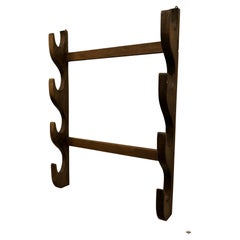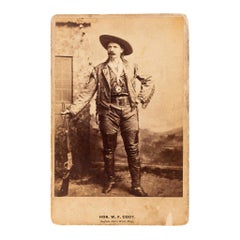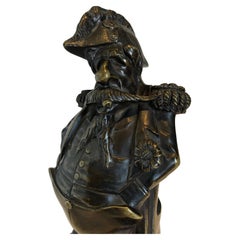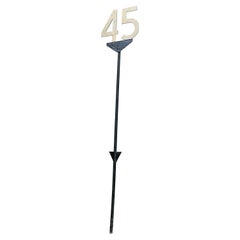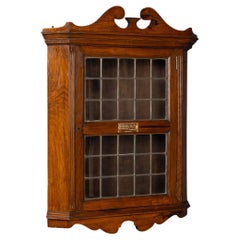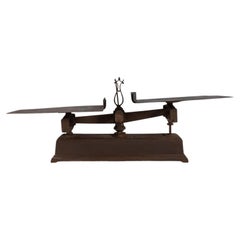Historical Memorabilia
to
332
941
806
1,861
28
7
210
89
81
80
61
46
38
21
17
14
12
10
8
3
3
1
123
557
1,181
35
343
484
207
40
42
37
66
50
73
125
86
48
37
871
418
368
226
197
966
567
513
252
182
1,896
1,895
1,896
15
14
6
4
4
Historical Memorabilia For Sale
French Oak Spit Rack Holder for Roasting Jacks
Located in Godshill, Isle of Wight
French Oak Spit Rack Holder for Roasting Jacks
This is a chunky country piece, it is made in 2” thick solid Oak and will hold 4 Spits
The Rack is in very good condition, it is ...
Category
19th Century Country Antique Historical Memorabilia
Materials
Oak
19th Century Buffalo Wild Bill Cody Cabinet Collectors Card
Located in Coeur d'Alene, ID
Buffalo Bill's Wild West Hon. W.F. Cody cabinet card by Anderson 785 Broadway, New York.
Period: Late 19th century
Origin: New York
Size: 4 1/4" x 6"
Family Owned & Operated
Cisco’...
Category
1880s Antique Historical Memorabilia
Materials
Other
Caricature Napoleon III Bronze Statuette, Signed Ham Late 19th Century
Located in Buenos Aires, Olivos
Caricature Napoleon III bronze statuette, Signed HAM late 19th century.
Bronze sculpture of Napoleon III, surellymade after leaving France, 19th century. A satirical political commen...
Category
Late 19th Century French Antique Historical Memorabilia
Materials
Marble, Bronze
British Rail Railway Speed Restriction Sign 45 MPH Original and very tall
Located in Godshill, Isle of Wight
British Rail Railway Speed Restriction Sign 45 MPH
Original and very tall, the sign is in good condition the paint has been restored in recent times
Overall height 115” (293cm), the...
Category
Mid-20th Century Industrial Historical Memorabilia
Materials
Iron
19thC Timber Corner Cabinet, Oak From HMS Foudroyant, Lord Nelson's Flagship
Located in Royal Tunbridge Wells, Kent
A 19th Century rare timber corner cabinet, made from the oak salvaged from the Foudroyant, Lord Nelson’s flagship. A lead glazed door with maker's copper plate for 'Goodall, Lamb & H...
Category
19th Century British Other Antique Historical Memorabilia
Materials
Glass, Oak
19th Century French Cast Iron Scale
Located in High Point, NC
This cast iron scale was made in France, circa 1900. A household and marketplace classic, scales of these dimensions were commonly used to weigh fruits...
Category
19th Century French French Provincial Antique Historical Memorabilia
Materials
Metal, Iron
Two Rare French Grand Railway Lamps B.B.T Makers Stamp 59265 from Paris Station
Located in Sofia, BG
Two rare French grand railway lamps with B.B.T makers stamp 59265 on each of them from Paris station. Made and used since 1920 one of them still with orig...
Category
Early 20th Century French Historical Memorabilia
Materials
Bronze
Iron Elevator Indicator Panel from The Fisher Building, Chicago, 1896
Located in Round Top, TX
A late 19th century cast iron elevator indicator panel from the famed Fisher Building designed and built by Daniel Burnham in 1896. The indicator de...
Category
Late 19th Century American Antique Historical Memorabilia
Materials
Iron
Design for a Silver Church Chalice, Illustration Attributed to Amor Fenn
Located in Godshill, Isle of Wight
Design for a Silver Church Chalice, Illustration attributed to Amor Fenn
Design illustration for a Silver Chalice attributed to Amor Fenn, with notes...
Category
Late 19th Century Arts and Crafts Antique Historical Memorabilia
Materials
Paper
1950s Central European Metal and Wooden Scooter
Located in High Point, NC
Step back in time with this authentic 1950s Central European Metal and Wooden Scooter, a whimsical piece that captures the playful spirit of yesteryears. Its sturdy construction features a combination of robust metal and solid wood, telling the tale of a bygone era where durability met simplicity in design. The scooter boasts original painted wheels with charming patina, and a spring mechanism that speaks to the ingenuity of mid 20th-century leisure inventions. Perfect as a unique decorative item in a vintage-themed space or as a conversation piece in an eclectic collection, this scooter is a nostalgic nod to the simple joys of childhood. It stands not just as a relic of the past but as an ode to the timeless appeal of classic toys.
Category
Mid-20th Century European Historical Memorabilia
Materials
Metal
Key Set 4 Gate Door Overall length 24cm, , 9.5" Diameter 10cm., 4"
Located in BUNGAY, SUFFOLK
An iron key ring with four massive keys
Overall length 24cm,, 9.5" Diameter 10cm., 4"
Each key Length 16cm., 6 1/2 in
Ring diameter 8cm., 3"
Category
19th Century English Antique Historical Memorabilia
Materials
Wrought Iron
20th Century Central European Metal and Wooden Scooter
Located in High Point, NC
Step back in time with this authentic 20th Century Central European Metal and Wooden Scooter, a whimsical piece that captures the playful spirit of yesteryears. Its sturdy construction features a combination of robust metal and solid wood, telling the tale of a bygone era where durability met simplicity in design. The scooter boasts original painted wheels with charming patina, and a spring mechanism that speaks to the ingenuity of early 20th-century leisure inventions. Perfect as a unique decorative item in a vintage-themed space or as a conversation piece in an eclectic collection, this scooter is a nostalgic nod to the simple joys of childhood. It stands not just as a relic of the past but as an ode to the timeless appeal of classic toys.
Category
20th Century European Historical Memorabilia
Materials
Metal
Large Victorian Queen’s Head Copper Wall Plaque
Located in Godshill, Isle of Wight
Large Victorian Queen’s head copper wall plaque
The plaque is from the 1890s , it was originally wall hung, it has been mounted on polished Oak...
Category
Late 19th Century Late Victorian Antique Historical Memorabilia
Materials
Copper
20th Century Central European Metal Bike
Located in High Point, NC
Discover a slice of history with this 20th Century Central European Metal Bike, a collector's delight that transcends time. Its durable metal construction a...
Category
20th Century European Historical Memorabilia
Materials
Metal
Vintage shoe last made of wood and iron
Located in Premariacco, IT
Vintage shoe last made of wood and iron
Category
1960s Italian Mid-Century Modern Vintage Historical Memorabilia
Materials
Iron
$233 / set
1918 Order Of Polonia Restituta; Commander's Cross
Located in Madrid, ES
1918 Order Of Polonia Restituta; Commander's Cross
1918 Order of Polonia Restituta; Commander's Cross - silver vermeil and enamels, 58x58mm, ornate ring suspension, original short pe...
Category
20th Century Historical Memorabilia
Materials
Sterling Silver
$519 Sale Price
20% Off
Art Nouveau Advertising Tile Poster from Codorniu's Cellar, Spain
Located in Vulpellac, Girona
Art Nouveau advertising tile poster from Codorniu Cellar, Spain
Ceramic tiles measurements: 15x15 cm (6x6 in).
Codorníu is synonymous to th...
Category
Early 20th Century Spanish Art Nouveau Historical Memorabilia
Materials
Ceramic
$34,014 Sale Price
20% Off
Original Sovietic War phone 1940s
Located in Byron Bay, NSW
Original Sovietic War phone 1940s
Category
1940s European Vintage Historical Memorabilia
Materials
Metal
A Wooden American Belle Bass Synagogue Memorial Sign, 1945
Located in New York, NY
An Interesting Wooden American Belle Bass Synagogue Memorial Sign, made in 1945 in the United States.
The sign is made of wood, stained in a rich, dark color, and smoothly finished, with each letter of the text nailed into the wood. The size of the sign is large enough to be prominently displayed in the Synagogue where the dedication was made. A Star of David is nailed to the top of the dedication followed by " The Belle Bass Memorial" in large, bold letters. The dedication Continues; The privilege of burning the mortgage was accorded to 'Jacob Bass...
Category
1940s American Vintage Historical Memorabilia
Materials
Wood
$560 Sale Price
20% Off
Antique Tarahumara Tesquino Vessel
Located in Coeur d'Alene, ID
This Tarahamara is a vessel that was used to make corn beer in Copper Canyon, Mexico. Complete with blacksmith forged stand. Rawhide wrapped for stability. A much used piece. Great l...
Category
Late 19th Century Mexican Antique Historical Memorabilia
Materials
Other
Late 19th Century American Jewish Themed Caricature
Located in New York, NY
American cartoon, USA, 1895.
Caption reads: 'A Natural Mistake. Ikenstein: "I vould like to ged a cheap drunk." Salesman: "Next door.'"
The cartoon is framed with American frame of t...
Category
1890s American Antique Historical Memorabilia
Materials
Paper
$3,440 Sale Price
49% Off
19th Century Moroccan Brass Hanukkah Lamp
Located in New York, NY
Hand hammed and hand engraved brass Hanukkah lamp, Morrocco, 19th century stands with oil fonts with pinched spouts attached to the back plate. Han...
Category
Late 19th Century Antique Historical Memorabilia
Materials
Brass
$3,292 Sale Price
20% Off
Early 20th Century Israeli Iron and Enamel Street Sign
Located in New York, NY
Three languages iron and enamel street sign, circa 1920.
The sign was made for 58 street in the city of Haifa. The three languages indicate the sig...
Category
1920s Vintage Historical Memorabilia
Materials
Iron, Enamel
$936 Sale Price
20% Off
USAF Strategic Air Command Task Force Metal Sign, 1980's.
Located in Canterbury, England
A very rare US Air force base metal sign, with reflective red paint and white reflective lettering to read 'USAF Strategic Air Command Task Force' with dimensions of 114cm by 71.5cm....
Category
1980s Vintage Historical Memorabilia
Materials
Metal
18th Century French Cast Iron Bound Strong Box, c.1740
Located in Royal Tunbridge Wells, Kent
Antique mid-18th century cast iron travel safe. Probably manufactured in France for storing money, important documents or jewellery. It would have been taken on long travels, perhaps on a long sea voyage or on the Orient express...
Category
18th Century French Antique Historical Memorabilia
Materials
Iron
Copper and Brass Country Grain Separator
Located in Coeur d'Alene, ID
Copper and brass grain separator from Iowa; complete. Seedburo equipment company, Chicago 1912.
Period: Last half of the 20th century.
Origin: Iowa
Si...
Category
Mid-20th Century American Historical Memorabilia
Materials
Brass, Copper
Victorian Wooden Scale Model Crane, circa 1880
Located in London, GB
Unusual large scale model of a late Victorian crane, circa 1880. Beautifully constructed in mahogany with brass binding and details and the original working metal winch and chains, a...
Category
Late 19th Century British Victorian Antique Historical Memorabilia
Materials
Brass
France Art Deco Horse, 1940
Located in Ciudad Autónoma Buenos Aires, C
It was exhibited in the original Miami beach antique show and Palm beach "American International Fine Art Fair (AIFAF)".
Horse in wood and chrome.
We ha...
Category
1940s French Art Deco Vintage Historical Memorabilia
Materials
Chrome
$22,000
19th Century Mortar and Pestle
Located in Coeur d'Alene, ID
19th century fruitwood mortar and pestle. Remnants of oxblood red and silver blue banded paint. Original pestle included.
Origin: Eastern, United States
Period: First half of the 19...
Category
Early 19th Century American Antique Historical Memorabilia
Materials
Fruitwood
An Early 20th Century Sign for Rav Naftali Horowitz , Boro Park, New York
Located in New York, NY
An early 20th-century sign for Rav Naftali Horowitz in Boro Park, New York for the diverse Jewish population who emigrated to New York in that period.
Painted in green, black, and o...
Category
Early 20th Century American Historical Memorabilia
Materials
Hardwood
$1,200 Sale Price
20% Off
Antique 18th Century Box of Georgian Keys Honble J A Ellis Kings Agent 1763-1776
Located in West Sussex, Pulborough
We are delighted to offer for sale this very rare small box of 27 Georgian keys of great importance
The box is stamped to the top “Honble J.A Ellis” an...
Category
18th Century English Georgian Antique Historical Memorabilia
Materials
Iron
West Germany Blown Glass Brown Dog Christmas Ornament
Located in Clifton Forge, VA
What an adorable reddish brown shiny dog ornament. He is standing on his hind legs and is so cute, I just want to scratch his belly. There is white overpaint on his droopy ears, nos...
Category
Mid-20th Century German Folk Art Historical Memorabilia
Materials
Blown Glass
$96 Sale Price
36% Off
1950s Gates Vulco Belts Vintage Painted Tin Sign or Sales Display Ratrod Garage
Located in Hyattsville, MD
Heavily Oxidized Painted Metal Sign, Faded Graphics, but a nice even fade. It is very tall for Wall Hanging Display or Leaning against a wall, at 55.75 inches high. Structurally th...
Category
1950s American Industrial Vintage Historical Memorabilia
Materials
Steel
$956 Sale Price
20% Off
SET OF SIX SPOONS AND LADLE IN PORTUGUESE SILVER 19th Century
Located in Madrid, ES
SET OF SIX SPOONS AND LADLE IN PORTUGUESE SILVER
19th Century
with relief and openwork decoration with 'Boar II' hallmarks of 833 milesimas, dated 1887-1937.
In original case.
Signs...
Category
19th Century Portuguese Baroque Antique Historical Memorabilia
Materials
Silver
$850 Sale Price
20% Off
1900s Belgian Metal and Wooden Wall Decorations, Set of Nine
Located in High Point, NC
A set of nine curiosities made in Belgium, circa 1900. Nine metal screens tensed on wooden frames and strengthened with wooden strips, hung through small metal clasps. The dark oxidi...
Category
Early 1900s Belgian Rustic Antique Historical Memorabilia
Materials
Metal
VINTAGE DISPLAY CASE FULL OF SHOOTiNG SNIPER MEDALS AND AWARDS MUST SEE PIECE
Located in West Sussex, Pulborough
Royal House Antiques
Royal House Antiques is delighted to offer for sale this very decorative display case housing multiple awards and medals for long distance sniper shooting...
Category
20th Century Other Historical Memorabilia
Materials
Glass, Wood
Very Unique Austrian Silver & Enamel Cigarette Case by Kurzer & Wolf, Dated 1916
By Kurzer & Wolf
Located in Ottawa, Ontario
This is without question a most unique Austrian silver cigarette case, the front of the case is decorated with a finely detailed road ma...
Category
Early 20th Century Austrian Vienna Secession Historical Memorabilia
Materials
Silver, Enamel
New Parade, 1960s
Located in Roma, IT
News Parade is an original film from the 1960s.
Complete edition. Castle films.
It includes original packaging.
16 mm. Good conditions.
Category
1960s European Vintage Historical Memorabilia
Materials
Plastic
PAiR OF ORIGINAL 1936 16MM CINEMA MOVIE SOUND REELS FOR "WHEN KNIGHTS WERE BOLD"
Located in West Sussex, Pulborough
Royal House Antiques
Royal House Antiques is delighted to offer for sale this super rare pair of original 16mm Sound Reels playing the 1936 movie “When Knights Were Bold” reel 1 and 2
A super collectable pair for any cinema buff, the cases occasionally come up for sale but never with the actual movie reels inside
The condition is period perfect as you can see, I’ll include the details of the movie belwo
Dimensions
Height:- 35cm
Width:- 35cm
Depth:- 2.5cm
Please note all measurements are taken at the widest point, if you would like any additional or specific measurements please ask
When Knights Were Bold is a 1936 British musical comedy film directed by Jack Raymond and starring Jack Buchanan, Fay Wray and Garry Marsh.[1] Songs include "Let's Put the People To Work" sung by Jack Buchanan, "Onward We Go" sung by Buchanan & soldiers' chorus, and "I'm Still Dreaming" sung by Buchanan.
Plot
Sir Guy de Vere...
Category
1930s English Art Deco Vintage Historical Memorabilia
Materials
Metal
New Parade, 1939
Located in Roma, IT
New Parade is an original film from the 1940s.
It includes original packaging.
8mm or 16mm.
Good conditions
Category
1930s European Vintage Historical Memorabilia
Materials
Plastic
$413
New Parade, 1939
Located in Roma, IT
New Parade is an original film from the 1940s.
It includes original packaging.
8mm or 16mm.
Good conditions
Category
1930s European Vintage Historical Memorabilia
Materials
Plastic
$413
New Parade, 1939
Located in Roma, IT
News Parade is an original film from the 1940s.
It includes original packaging.
8 mm or 16 mm.
Good conditions.
Category
1930s European Vintage Historical Memorabilia
Materials
Plastic
$413
Sport Parade, 1950s
Located in Roma, IT
Sports parade film is an original film from the 1950s.
It includes original packaging.
8mm or 16mm.
Good conditions
Category
1950s European Vintage Historical Memorabilia
Materials
Plastic
Mid-20th Century Israeli Brass and Enamel Hanukkah Lamp
Located in New York, NY
Brass Hanukkah lamp, Israel, 1950s. Enamel over brass. Marked on bottom, "made in Israel." The front scene depicts the Maccabees against Roman soldiers over the battle of Jerusalem. ...
Category
Mid-19th Century Israeli Antique Historical Memorabilia
Materials
Brass
$1,492 Sale Price
20% Off
BRITISH CAMPAIGN & GALLANTRY MEDALS DiSPLAY PICTURE VERY DECORATIVE EXAMPLE
Located in West Sussex, Pulborough
Royal House Antiques
Royal House Antiques is delighted to offer for sale this very decorative display case housing multiple medals for Britich Campaign & Gallantry
Please note the...
Category
20th Century English Campaign Historical Memorabilia
Materials
Brass
1815 Spanish Passport Hand Written on Paper
Located in Marbella, ES
1815 Spanish passport hand written on paper. Part of a large collection.
Category
Early 19th Century Spanish Antique Historical Memorabilia
Materials
Paper
Ferrocarril Oeste - Once to Puerto Madero Freight Tunnel Commemorative Plaque
Located in Braintree, GB
1916 Ferrocarril Oeste - Once to Puerto Madero Freight Tunnel Commemorative Plaque.
This stunning commemorative bronze plaque, crafted in 1916, celebrates the construction of the Fr...
Category
1910s Argentine Vintage Historical Memorabilia
Materials
Bronze
Vintage, Swimming Flicker Book No.15 High Dives
Located in Oxfordshire, GB
A very nice flicker book, American girl champions. Flicker No.15. High Dives. This is a unusual flicker book, showing two high dives.
Flicker books where...
Category
20th Century Central American Sporting Art Historical Memorabilia
Materials
Paper
Ute Sheep Horn Spoon, circa 1870
Located in Coeur d'Alene, ID
Ute sheep horn spoon with old tag “Ute, Pine River, Battle, Ex. Cottchall Collection. Collected 1870.” Brain tanned with blue and white beading on top.
Per...
Category
Late 19th Century American Native American Antique Historical Memorabilia
Materials
Horn
Pair Plateau Parfleche Packets
Located in Coeur d'Alene, ID
Matched pair of Plateau parfleche packets with diamonds and stylized flowers and brain tanned ties. Difficult to find a pair. Very nice, rare design.
The term parfleche was first co...
Category
Early 1900s American Native American Antique Historical Memorabilia
Materials
Other
$9,680 / item
Vintage 20th Century "Not In Service" Framed London Red Route Bus Sign c.1960
Located in Royal Tunbridge Wells, Kent
A wonderful mid 20th Century Transport for London sign, hailing from the iconic red route master buses of London. This piece of history is elegantly framed in black. Whether for enth...
Category
1960s British Other Vintage Historical Memorabilia
Materials
Wood
Le Poulain Original Decorative Motorcycle
Located in Zedelgem, BE
Decorative motorbike of the 50's - 60's, it does run but needs a bit of tender loving care, a truly fun item.
Category
Mid-20th Century French Other Historical Memorabilia
Materials
Iron
Joined at the Heart, Signed by Al and Tipper Gore, First Edition, 2002
Located in Colorado Springs, CO
Gore, Al and Tipper. Joined at the Heart. New York: Henry Holt and Company, 2002. First Edition. Signed by both authors. Octavo. In publisher’s original white cloth spine, titled in ...
Category
Early 2000s American Historical Memorabilia
Materials
Paper
Pair of Signed Antique Repouse Metal Wall Plaques of Noble or Historical Men
Located in Hamilton, Ontario
This pair of antique wall plaques are possibly signed by an unknown artist, or identify the respective individuals in both, and are presumed to ori...
Category
Late 19th Century English Victorian Antique Historical Memorabilia
Materials
Metal
Chinese Black Silk Lotus Slippers with Plum Blossoms, c. 1850
Located in Chicago, IL
These pointed slippers, beautifully embroidered with light blue plum blossoms on black silk, were shaped to resemble a lotus bud and enhanced the diminutive shape of bound feet. A practice that began in the Tang dynasty and reached the height of its popularity during the Qing dynasty, foot binding was a painful process intended to make a woman's feet as small as possible by restricting bone growth from an early age. The smaller the feet the more attractive and erotic they were, giving elite women a mark of elegance and a distinctive - albeit tortured - gait of small, light steps. These beautifully preserved lotus slippers...
Category
Mid-19th Century Chinese Qing Antique Historical Memorabilia
Materials
Silk
George VI Coin Coronation Goblet
Located in New Orleans, LA
A special silver coin commemorating the coronation of King George VI and Queen Elizabeth is inset into the base of this limited edition glass goblet. Crafted...
Category
20th Century English Other Historical Memorabilia
Materials
Glass
Antique Large Tiled Advertising Panel for Codorniu Cava, 1930s
Located in Vulpellac, Girona
This large advertising panel for Codorniu cava was designed during the 1930s and it clearly symbolises Art Nouveau design. It consists of 20cm by 20c...
Category
Early 20th Century Spanish Art Nouveau Historical Memorabilia
Materials
Ceramic
Pair of Warship Paintings by Charles De Lacy, British, 1856-1929
Located in Royal Tunbridge Wells, Kent
A pair of original gauche paintings by Charles John de Lacy, illustrating the interior of two different warships. These detailed cutaway technical drawings wer...
Category
19th Century British Antique Historical Memorabilia
Materials
Paint
Early 20th Century French Silver Schnapps Cup
Located in New York, NY
Sterling silver Zionist Schnapps cup, France, circa 1920.
This shot cup is decorated with a Star of David enclosed in a wreath with a bow, and the word “Zion” in Hebrew. Marked with...
Category
Early 20th Century French Historical Memorabilia
Materials
Silver
$1,080 Sale Price
20% Off
Wilson Chilton’s mahogany Naval Architects/draughtsman box of curves/templates
Located in Lymington, Hampshire
Wilson Chilton’s mahogany Naval Architects/Naval draughtsman box of curves and templates, probably by Gillows still retaining around 100 superb quality...
Category
19th Century English Antique Historical Memorabilia
Materials
Mahogany
Recently Viewed
View AllMore Ways To Browse
John Quincy Adams
Judges Gavel
Mt Vernon Antique Furniture
Pub Memorabilia
Antique Magic Lantern Glass Slide
Antique Voting Box
Antique Wooden Cash Register
Artillery Vase
Emancipation Proclamation
Magic Lantern Slides
The Beatles Memorabilia
The Federalist Antiques
Used Vornado Fan
Vintage Christmas Tree Toppers
Vornado Fan
Ww1 Memorabilia
Ww2 Binoculars
Absinthe Set
